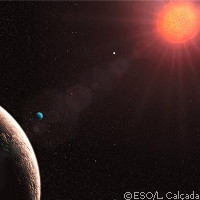Europeans discover lightest exoplanet
A cross-European team of astronomers has discovered the lightest exoplanet (a planet beyond the Solar System) ever by using the European Southern Observatory's (ESO) HARPS spectrograph - what many consider as being the best 'low mass-exoplanet hunter' in the world - attached to the 3.6-metre ESO telescope in Chile. Located in the Gliese 581 system, the exoplanet 'e' has around twice the mass of Earth. During the four-year study, the scientists also refined the orbit of the planet Gliese 581 d (first discovered in 2007), and placed it within the habitable zone. 'The holy grail of current exoplanet research is the detection of a rocky, Earth-like planet in the "habitable zone", a region around the host star with the right conditions for water to be liquid on a planet's surface,' explained project leader Professor Michel Mayor from the Geneva Observatory in Switzerland. Planet Gliese 581 e orbits its host star in only 3.15 days. The host star is located 20.5 light-years away in the constellation Libra (the 'Scales'). 'With only 1.9 Earth-masses, it is the least massive exoplanet ever detected and is, very likely, a rocky planet,' said Mr Xavier Bonfils of the Grenoble Observatory in France. The planet is not in the habitable zone since its location is so near its host star. However, the astronomers found that another planet ('d') in this system seems to be in the habitable zone. According to their research, a star was recognised as harbouring a system with a planet the size of Neptune (ESO 30/5) and two 'super-Earths' (ESO 22/7). 'Gliese 581 d is probably too massive to be made only of rocky material, but we can speculate that it is an icy planet that has migrated closer to the star,' stated Professor Stephane Udry, a member of the research team. 'The new observations have revealed that this planet is in the habitable zone, where liquid water could exist. [Planet] "d" could even be covered by a large and deep ocean; it is the first serious "water world" candidate,' he added. Thanks to this groundbreaking discovery, the astronomers now count four planets in the planetary system. Their masses stand at 1.9 (planet e), 16 (planet b), 5 (planet c) and 7 Earth-masses (planet d). They noted that Gliese 581 d, which is the furthest planet, orbits its host star in 66.8 days. According to the scientists, an exoplanet introduces a small 'wobble' in the star's motion as it orbits its host star - only about seven kilometres per hour. The team said this corresponds to a person walking at a brisk speed. Gliese 581 is a low-mass, red dwarf star, and researchers believe these types of stars are prime locations for low-mass exoplanets in the habitable zone. These cool stars are 'relatively faint', the team said, adding that their 'habitable zones lie close in, where the gravitational tug of any orbiting planet found there would be stronger, making the wobble more pronounced'. Professor Mayor remarked, 'It is amazing to see how far we have come since we discovered the first exoplanet around a normal star in 1995, the one around 51 Pegasi. The mass of Gliese 581 e is 80 times less than that of 51 Pegasi b. This is tremendous progress in just 14 years.' They noted their work is not done, however. 'With similar observing conditions, an Earth-like planet located in the middle of the habitable zone of a red dwarf star could be detectable,' Mr Bonfils noted. 'The hunt continues.' The results of this study have been submitted for publication in the journal Astronomy and Astrophysics.
Countries
Switzerland, France



